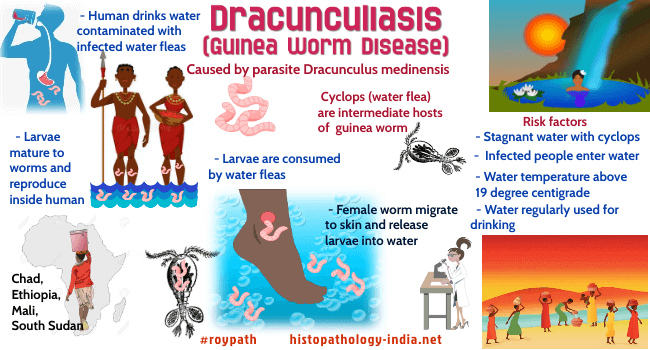Free Courses Sale ends Soon, Get It Now


Free Courses Sale ends Soon, Get It Now



Copyright infringement not intended
Picture Courtesy: https://www.histopathology-india.net/Dracun.htm
Context: The global effort to eradicate Guinea worm disease has achieved significant success, with reported cases decreasing from over 3.5 million in the 1980s to just six cases in 2023, according to the World Health Organization report.
About Guinea Worm Disease
|
Aspect |
Details |
|
Disease |
Guinea worm disease (dracunculiasis) |
|
Caused by |
Dracunculus medinensis parasite |
|
Transmission |
Infection occurs when people consume water contaminated with copepods carrying infective larvae. After ingestion, larvae mature into adult worms in the human host. The female worm, when ready to lay eggs, emerges through a blister on the skin, releasing larvae upon contact with water. |
|
Symptoms |
Painful blister (often on leg/foot), slow emergence of adult worm (up to 1 meter), inflammation, secondary infections, fever, nausea, vomiting, disability |
|
Prevalence |
Significantly reduced in recent decades; cases reported mainly in sub-Saharan Africa, particularly in South Sudan, Chad, and Mali |
|
Eradication progress |
99.99% reduction in cases, nearing eradication |
|
Preventive Measures |
Clean water access: Treating water sources with larvicide (Temephos) to kill larvae. Community education: Raising awareness about transmission, prevention, and reporting cases. Surveillance: Tracking cases, identifying hotspots, and containing outbreaks. Intersectoral collaboration: Government, health workers, and international organizations working together. |
|
Challenges remaining |
Chad and Central African Republic: These countries have the majority of remaining cases. Animal reservoirs: Guinea worms found in dogs in Chad, posing potential transmission risks. Poverty and lack of resources: Limited access to clean water, sanitation, and healthcare hinders prevention and treatment. Political instability: Conflict disrupts public health campaigns and hinders eradication efforts. |
|
India's success |
Eliminated disease in the late 1990s through a rigorous campaign focusing on water safety, community engagement, and surveillance. Received WHO certification in 2000. |
|
Importance of vigilance |
Continued efforts are needed to address remaining challenges and prevent resurgence. Animal reservoirs: Monitor and potentially treat animal infections. Capacity building: Strengthen healthcare systems and community engagement in affected countries. Political stability: Advocate for peace and security to support public health efforts. |
|
Interplay of health and social issues |
Eradication efforts are linked to poverty, conflict, and social development. Addressing these issues is crucial for sustainable health improvements. |
Conclusion
|
PRACTICE QUESTION Q. Which of the following is the parasite responsible for Guinea worm disease? A. Plasmodium falciparum B. Dracunculus medinensis C. Schistosoma mansoni D. Onchocerca volvulus
Answer: B Explanation: The correct answer is B. Dracunculus medinensis is a parasitic nematode (roundworm) that causes Guinea worm disease. Plasmodium falciparum causes malaria, Schistosoma mansoni causes schistosomiasis, and Onchocerca volvulus causes river blindness. |
© 2024 iasgyan. All right reserved